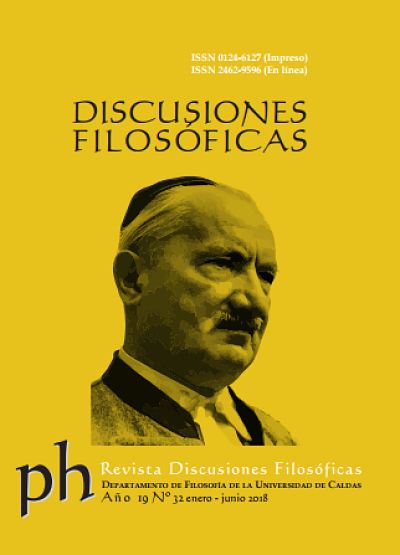Autores/as
Resumen
Este artículo defiende que la teorización sobre la capacidad para atención conjunta debe esclarecer los conceptos de intención y experiencia: una tarea eminentemente filosófica. Se exponen los aspectos psicológicos relevantes, las posiciones teóricas más destacadas y se analiza filosóficamente el estado de la cuestión. Se concluye que no hay consenso interteórico sobre los aspectos operacionales ni sobre los funcionales que definen la capacidad, y que la inmadurez de la teoría se debe a una elaboración todavía precaria de sus conceptos centrales, intención y experiencia, tarea en la que la filosofía realizaría un aporte decisivo.
Palabras clave
Citas
Baron-Cohen, Simon. Mindblindness: An Essay on Autism and Theory of Mind. Cambridge: The MIT Press. 1995. Print.
---. “The Eye Detection Detector (EDD) and the Shared Attention Mechanism (SAM): Two Cases for Evolutionary Psychology”. Joint Attention. Its Origins and Role in Development. New York: Lawrence Erlbaum Associates. 1995. 41-59. Print.
Bruner, Jerome. Child’s talk. Learning to Use Language. New York: Oxford University Press. 1983. Print.
---.“From Joint Attention to the Meeting of Minds: An Introduction”. Joint Attention. Its Origins and Role in Development. New York: Lawrence Erlbaum Associates. 1995. 1-14. Print.
Butterworth, George. “Origins of Mind in Perception and Action”. Joint Attention. Its Origins and Role in Development. Nueva York: Lawrence Erlbaum Associates. 1995. 29-40. Print.
Carpenter, Melinda, et al. “Social Cognition, Joint Attention, and Communicative Competence from 9 to 15 Months of Age” Monographs of the Society for Research in Child Development, 63 (4). 1998: 1-174. Web.
Casasanto, Daniel. “Linguistic Relativity” Routledge handbook of semantics. New York: Routledge, 2016, 158-174. Print.
Corkum, Valerie and Chris Moore. “Development of Joint Visual Attention in Infants” Joint Attention. Its Origins and Role in Development.
New York: Lawrence Erlbaum Associates. 1995. 61-83. Print.
Davidson, Donald. Mente, mundo y acción. Barcelona: Paidós. 1992. Impreso.
Escudero-Sanz, Alfonso, et al. “Aparición y desarrollo de la atención conjunta en la infancia” Anales de psicología, 29 (2). 2013: 402-412. Web.
Gopnik, Alison and Henry Wellman. “Why the child’s Theory of Mind really is a Theory?” Folk psychology. Cambridge: Wiley Blackwell. 1995. 233-258. Print.
Grice, Paul. “Logic and Conversation” Syntax and Semantics, Vol. 3, Speech Acts Nueva York: Academic Press. 1975: 41-58. Web.
Gunther, York. Essays on Nonconceptual Content. Cambridge: The MIT Press. 2003. Print.
Hobson, Peter. “On Sharing Experiences” Development and psychopathology, 1. 1989: 197-203. Web.
---.“What Puts the Jointness in Joint Attention?” Joint Attention, Communication and Other Minds. New York: Oxford University Press. 2005. 185-204. Print.
Hobson, Peter and Jessica Hobson. “Joint Attention or Joint Engagement? Insights from Autism” Joint Attention. New Developments in Psychology, Philosophy of Mind and Social Neuroscience. London: The MIT Press. 2011. 115-135. Print.
Kim, Jaegwon. Philosophy of Mind. Boulder: Westview Press. 2006. Print.
Kita, Sotaro. Pointing: Where Language, Culture, and Cognition Meet. New Jersey: Lawrence Erlbaum Associates. 2003. Print.
Moore, Chris and Philip Dunham. Joint Attention. Its Origins and Role in Development. New York: Lawrence Erlbaum Associates. 1995. Print
Pérez Jiménez, Miguel Ángel. La aparición del pensamiento. Una enmienda emotiva a la tesis de Donald Davidson. Granada: Universidad de Granada. 2009. Impreso.
Racine, Timothy. The Role of Shared Practice in the Origins of Joint Attention and Pointing. Simon Fraser University. 2005. Web.
---.Getting beyond rich and lean views of joint attention” Joint Attention. New Developments in Psychology, Philosophy of Mind and Social Neuroscience. London: The MIT Press. 2011. 21-42. Print.
Reddy, Vasudevi. “A Gaze at Grips with Me” Joint Attention. New Developments in Psychology, Philosophy of Mind and Social Neuroscience. London: The MIT Press. 2011. 137-157. Print.
Scaife, Michael and Jerome Bruner. “The capacity of joint visual attention in the infant”. Nature, 253. 1975: 265-266. Web.
Seeman, Axel. Joint Attention. New Developments in Psychology, Philosophy of Mind and Social Neuroscience. London: The MIT Press. 2011. Print.
Sigman, Marian and Connie Kasari. “Joint Attention across Contexts in Normal and Autistic Children” Joint Attention. Its Origins and Role in Development. New York: Lawrence Erlbaum Associates. 1995. 189-203. Print.
Solomon, Robert. Ética emocional: Una teoría de los sentimientos. Barcelona: Paidós. 2007. Impreso.
Tomasello, Michael and Jodie Todd. “Joint Attention and Early Lexical Acquisition Style” First language, 4. 1983: 197-212. Web.
Tomasello, Michael and Anne Cale Kruger. “Joint Attention on Actions. Acquiring Verbs in Ostensive and Non-Ostensive Contexts” Journal of Child Language, 19. 1992: 311-333. Web.
Tomasello, Michael et al. “Understanding and Sharing Intentions: The Origins of Social Cognition”. Behavioral and Brain Sciences, 28. 2005: 675-735. Web.
Tomasello, Michael. “The Role of Joint Attention in Early Language Development” Language Sciences, 11. 1988: 69-88. Web.
---. “Joint Attention as Social Cognition”. Joint Attention. Its Origins and Role in Development. New York: Lawrence Erlbaum Associates. 1995. 103-130. Print.
---. Los orígenes culturales de la cognición humana. Buenos Aires: Amorrortu Editores. 2007. Impreso.
Trevarthen, Colwyn. “Los motivos primordiales para entenderse y cooperar” La comunicación preverbal, Barcelona: Ediciones Avesta. 1982. Impreso.
---. “The Generation of Human Meaning: How Shared Experience Grows in Infancy”. Joint Attention. New Developments in Psychology, Philosophy of Mind and Social Neuroscience. London: The MIT Press. 2011. 73-113. Print.
Wellman, Henry. The Child’s Theory of Mind. Cambridge: The MIT Press. 1990. Print.
Werner, Heinz and Bernard Kaplan. Symbol formation. New York: Psychology Press. 1963. Print.
Wilde, Janet and Jodie Baird. Why Language Matters for Theory of Mind. Nueva York: Oxford University Press. 2005. Print.

 pdf
pdf
 FLIP
FLIP

























